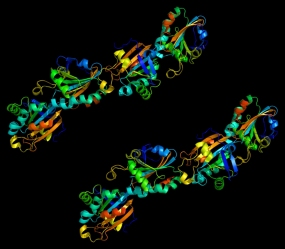Communicative peroxidases
Reactive oxygen species (ROS) are oxidizing molecules that are produced, for example, in cellular respiration and in inflammatory processes. They can damage cellular components and the genetic material. On the other hand, oxidizing molecules, particularly so-called peroxides, also play a role in cellular signal transmission. Scientists from the German Cancer Research Center (DKFZ) have now shown that antioxidative enzymes have a communicative side. They not only break down peroxides but also transmit their oxidative effect in a controlled manner to other proteins, thus transmitting cellular signals.
Oxidizing chemical compounds called reactive oxygen species (ROS) can be produced as a side product of cellular respiration or inflammatory processes. These reactive molecules (oxidants) can damage components of the cell or cause alterations in DNA. Therefore, levels of oxidants in body cells are strictly controlled and kept very low by antioxidative enzymes.
On the other hand, the body's own oxidants, particularly so-called peroxides, also have communication functions in the cell. They oxidize proteins at particular sites, thus changing their signaling properties. These oxidative signals enable the cell to adapt rapidly to changes in environmental or metabolic conditions.
However, measurements have shown that peroxidases – enzymes which protect the body from oxidative damage by degrading peroxides – work extremely efficiently, such that selective oxidation of signaling proteins should essentially be impossible. Up to now, it had remained enigmatic how oxidation of signaling proteins can take place if oxidants are removed thus efficiently from the cell.
Current results of a research team led by Tobias Dick from the German Cancer Research Center (Deutsches Krebsforschungszentrum, DKFZ) in Heidelberg have shown that a class of peroxidases called peroxiredoxins has a particular role in cellular signal transduction. Beyond simply removing peroxides and thus protecting the cell from uncontrolled oxidation, they are also capable of transmitting the oxidative effect of peroxides in an orderly manner to signaling proteins.
There appears to be a division of labor: Most peroxiredoxin molecules efficiently and completely remove peroxides, thus protecting the cell as a whole. Small local clusters of the same peroxiredoxins, however, facilitate oxidation of neighboring proteins whose function is regulated by oxidation.
The researchers discovered this by eliminating the genetic information for peroxiredoxins from the genetic material of human cells. Contrary to general expectations, oxidation of cellular proteins did not increase as a result. Instead, the oxidation level of signaling proteins was reduced.
"We observed in this study that in the absence of peroxiredoxins, hardly any signaling proteins are oxidized," said Sarah Stöcker, who is the first author of the study. "This means that peroxidases not only prevent the negative effects of oxidant formation, they also mediate their positive function as signals. We now know that peroxidases are global antioxidants on the one hand and local oxidants on the other."
The new results prompt researchers to rethink the role of antioxidative enzymes in carcinogenesis. "Expression of peroxidases in tumor tissue has often undergone alterations. Until now, cancer researchers have been interested in the consequences of this defect with a view to the antioxidative function," Dick said. "Now the question is whether the disrupted communicative function of peroxidases might also play a role in the development of cancer."
The research project is part of the Collaborative Research Center 1036 (SFB 1036), which pursues research on basic mechanisms of cellular stress response within the DKFZ-ZMBH alliance. The SFB is funded by the German Research Foundation (DFG).
Sarah Stöcker, Michael Maurer, Thomas Ruppert, Tobias P. Dick (2017): A role for 2-Cys peroxiredoxins in facilitating cytosolic protein thiol oxidation.
Nature Chemical Biology 2018, DOI: 10.1038/nchembio.2536
With more than 3,000 employees, the German Cancer Research Center (Deutsches Krebsforschungszentrum, DKFZ) is Germany’s largest biomedical research institute. DKFZ scientists identify cancer risk factors, investigate how cancer progresses and develop new cancer prevention strategies. They are also developing new methods to diagnose tumors more precisely and treat cancer patients more successfully. The DKFZ's Cancer Information Service (KID) provides patients, interested citizens and experts with individual answers to questions relating to cancer.
To transfer promising approaches from cancer research to the clinic and thus improve the prognosis of cancer patients, the DKFZ cooperates with excellent research institutions and university hospitals throughout Germany:
The DKFZ is 90 percent financed by the Federal Ministry of Education and Research and 10 percent by the state of Baden-Württemberg. The DKFZ is a member of the Helmholtz Association of German Research Centers.


